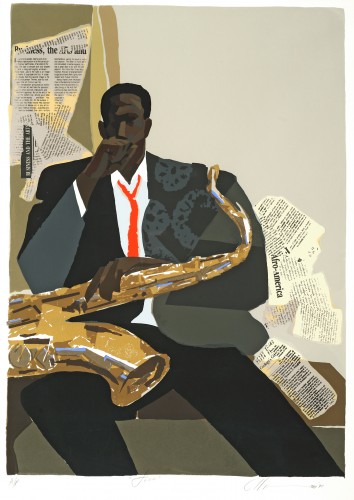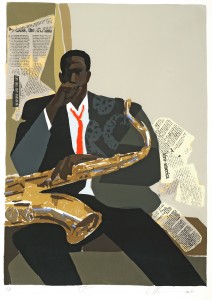
Ken Burns Jazz – Episode 10: “A Masterpiece by Midnight”
75 Russell Street
Lewiston, ME 04240

Joseph Holston, Jazz, 1990, Screenprint
By the early 1960s, jazz is in trouble. Young people now overwhelmingly prefer rock ’n roll – though Louis Armstrong manages to outsell the Beatles with “Hello Dolly” and Stan Getz helps boost a craze for Bossa Nova. Desperate for work, some musicians go into exile overseas, including the tenor saxophone master, Dexter Gordon. Critics divide the music into antagonistic “schools” – Dixieland, swing, bebop, hard bop, modal, Free, avant-garde, and more. During the civil rights struggle, some artists mix music with social protest, including Max Roach, Charles Mingus, Archie Schepp, and the Art Ensemble of Chicago. John Coltrane dies young, and Miles Davis decides that if he cannot outsell rock musicians he should join forces with them, creating the enormously popular music called Fusion. Both Louis Armstrong and Duke Ellington pass away during the 1970s, and to some, jazz seems to die with them. But just when things seem most desperate, Dexter Gordon returns from Europe, and proves that there is still an audience for mainstream jazz, and a new generation of musicians, led by the trumpeter Wynton Marsalis, emerges, eager to express themselves within the music’s great traditions. The musical journey that began in the dance halls and saloons and street parades of New Orleans in the early years of the 20th. century continues – and shows no sign of slowing down. As it enters its second century, jazz is still alive, still changing and still swinging.